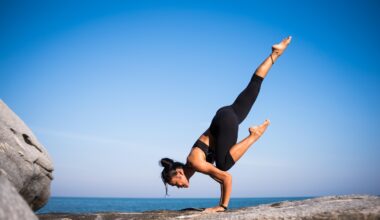Improving Balance and Coordination Through Functional Movement
Improving balance and coordination is essential for overall health and fitness. Functional movement patterns are activities that mimic everyday tasks, maximizing readiness for real-life challenges. These movements enhance the body’s efficiency in various activities, making them vital in functional fitness training. Incorporating exercises that focus on balance helps athletes and non-athletes alike engage their core, support muscle coordination, and create stability. By embedding these exercises into a workout routine, one can achieve better body awareness. Specific balance exercises can target different muscle groups, utilizing techniques such as single-leg stands, lateral lunges, and the use of stability balls. This can be beneficial in improving overall performance and daily functionality. Not only do balance exercises foster physical strength, but they also encourage mental focus and resilience. Additionally, functional movements facilitate improvement in proprioception, an essential skill in sports. Practicing these fundamental movements leads to enhanced agility and coordination, which are crucial in many sports and recreational activities. As a result, athletes can effectively react to rapid changes in their environment, reducing the likelihood of injuries often caused by poor balance.
Functional movements are inherently tied to various physical activities, including strength training, aerobic workouts, and sports. They encompass motions like squatting, pushing, pulling, and rotating. When properly integrated into a training regimen, these movements improve physical performance drastically. Engaging multiple muscle groups not only aids coordination but also builds strength, stamina, and flexibility beneficial for daily activities. Training with functional movements can lead to better posture and less strain on the body during everyday tasks. These exercises enhance motor skills and can be customized to individual fitness levels. By including exercises such as kettlebell swings, deadlifts, and overhead presses, practitioners build balanced muscle development. Furthermore, it allows for functional strength, contributing to improved athletic performance. Practicing functional movements can also enhance metabolic active tissue, facilitating weight loss and better body composition. The holistic approach of functional fitness training integrates strength, balance, and flexibility, leading to optimal health. As our bodies often require adaptability, improving our functional movement patterns can help ensure we remain agile and coordinated throughout life. Incorporating such methods leads to longer-term fitness benefits and a healthier lifestyle overall.
Core stability plays a significant role in balance and coordination improvement. A strong core supports functional movements, providing necessary stability when performing various exercises. An unstable core may compromise physical performance and could increase the risk of injury. Engaging in activities that target the abdominal and lower back muscles directly contributes to core strength. Exercises such as planks, dead bugs, or medicine ball throws help develop core stability. Additionally, focusing on breathing patterns during these exercises aids muscle engagement, pushing individuals to maximize their workout effectiveness. Developing a strong core allows for better control of limbs during dynamic movement. Proper integration of muscle groups helps maintain balance across various postures and activities. Improved stability leads to enhanced posture as well, contributing to healthy biomechanics. As a result, functional movements can be performed smoothly and efficiently. Somatic and rhythmic movements can increase awareness, providing real-time feedback on progress. Enhancing core strength results in improved athletic performance and quality of life. Individuals can freely participate in sports and enjoy recreational activities without the fear of loss of balance or coordination, reinforcing self-confidence.
The Role of Flexibility in Balance
Flexibility is another crucial component when considering balance and coordination. Stretching enhances muscle elasticity, contributing to improved functional movement performance. By increasing range of motion in joints, individuals can perform movements effectively. Flexibility helps reduce muscular tension, which can greatly influence balance during various activities. Incorporating dynamic stretching into a warm-up routine prepares the body for subsequent workouts. Activities focusing on hip, shoulder, and spinal flexibility yield excellent results in functional fitness. Exercises such as yoga, Pilates, and specific stretching routines offer significant flexibility benefits. Enhanced flexibility coupled with focused balance exercises elevates the overall fitness level. This enables individuals to perform movements with better control, agility, and precision. Furthermore, flexibility helps to maintain joint health and prevents injuries. As people age, they tend to lose flexibility, leading to increased chances of falls or injuries. Practicing a combination of strength, balance, and flexibility exercises yield optimal results for overall fitness. Engaging in a consistent routine not only keeps the body mobile but also prevents stiffness. Ultimately, a well-rounded fitness approach allowing for flexibility is integral in maintaining balance and coordination.
To maximize balance and coordination improvement, one should incorporate various training modalities. Cross-training effectively incorporates multiple fitness disciplines into a routine. Engaging in different forms of exercise exposes the body to diverse movements, which can considerably enhance balance. Swimming, cycling, and martial arts provide unique challenges for vestibular and proprioceptive systems. Activities such as agility ladder drills and balance boards can further challenge coordination and stability. Consistency is vital in building these skills; thereby, dedicating time throughout the week to practice is essential for progress. Establishing measurable goals allows individuals to track improvement effectively over time. Progress does not happen overnight, requiring patience and commitment to achieve desirable results. Participating in group classes or teaming up with others can provide motivation and accountability, making workouts more enjoyable. Setting aside specific times each week for balance training allows the body to adapt to new demands. Additionally, engaging in outdoor activities such as hiking or rock climbing can introduce natural instability, enhancing balance skills. Integrating various sports, along with targeted functional movements enables comprehensive development across physical capabilities essential for life.
Conclusion and Future Steps
In conclusion, improving balance and coordination through functional movement patterns is a rewarding journey. Engaging in such exercises builds strength, flexibility, and stability, enhancing overall fitness. Practitioners not only benefit physically but mentally as well, becoming more confident in their abilities. Addressing one’s unique needs and tailoring workouts to those specifications leads to optimal results. Setting specific short-term and long-term goals empowers individuals to stay motivated. Continually tracking progress ensures consistency while identifying areas needing improvement. Education plays a vital role in understanding the importance of functional movements and their applications. Prioritizing injury prevention must remain paramount throughout one’s fitness journey. Considering age, health conditions, and history of injuries will lead to specific guidance for each individual. Seeking expert advice is invaluable in progressively advancing within functional fitness. Commitment to practice can result in remarkable changes, leading to healthier lifestyles long-term. Investing time in developing balance and coordination will serve individuals well throughout all aspects of life, preserving mobility well into older age. Consequently, embracing functional movement patterns will support active participation in various activities, making for richer life experiences moving forward.
Ultimately, enhancing balance and coordination through functional movements is crucial for everyday activities and sports. By understanding the interplay of strength, flexibility, and core stability, practitioners can develop more efficient movement patterns. Not only is improved physical performance a goal but also ensuring confidence in one’s mobility. Incorporating varieties of exercises creates a dynamic workout experience, addressing different needs and goals. Engaging with a community or group further motivates individuals to remain active. Recognizing the importance of effective training methods will help individuals satisfy their personal fitness objectives. As time flits by, maintaining functional fitness and balance becomes increasingly vital. This ensures an individual leads a healthy, active life as they age; ultimately prolonging their ability to partake in life’s activities. By embracing functional movement patterns, people can foster a sustainable relationship with fitness, allowing for longevity and vitality. Therefore, acknowledging the importance of balance and coordination is essential in comprehensively developing one’s physical skill set. Taking the time to learn proper techniques, guided involvement, and consistent practice yields immense benefits. With dedication, one can achieve remarkable results by investing in balance and coordination through functional fitness!


